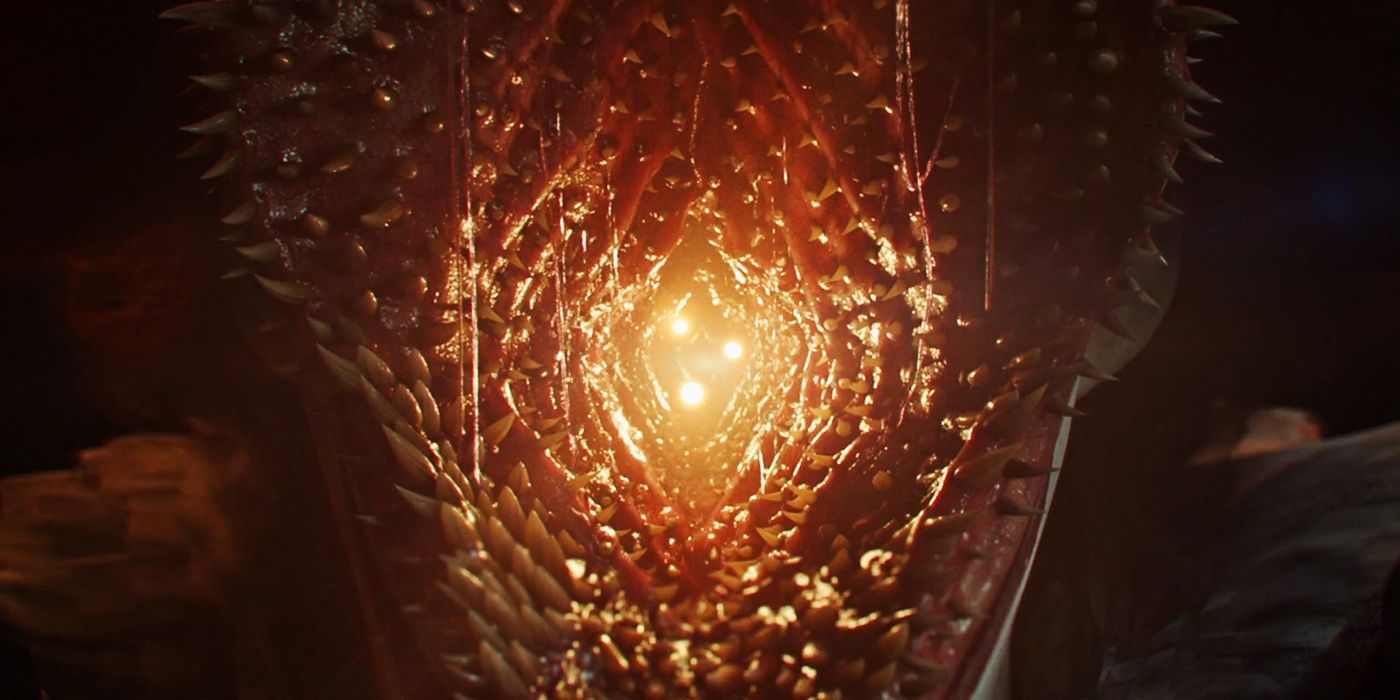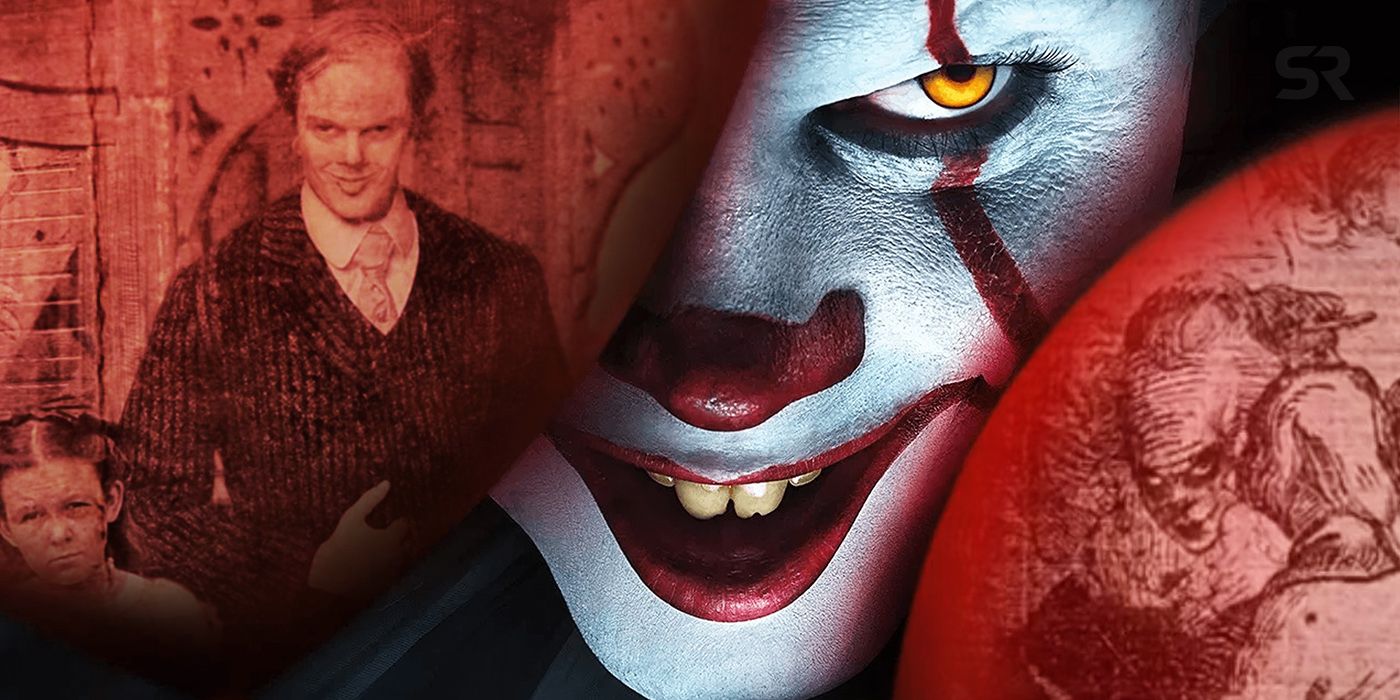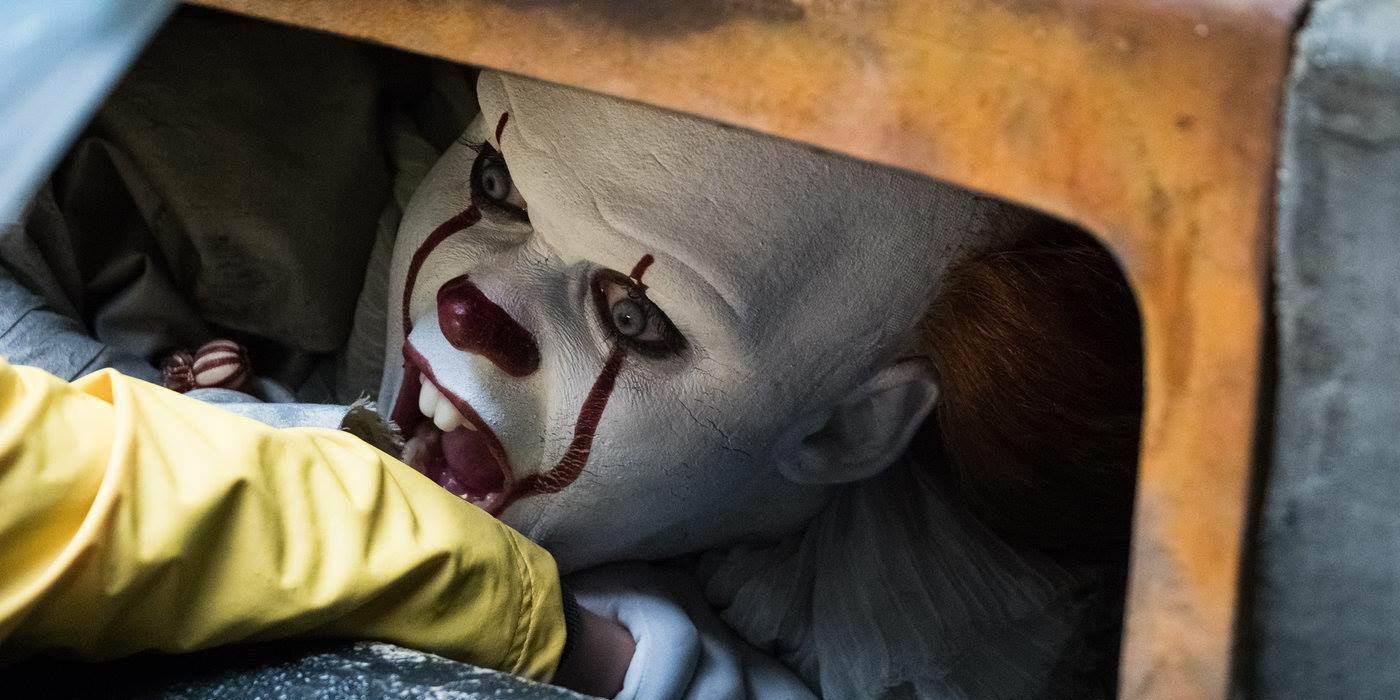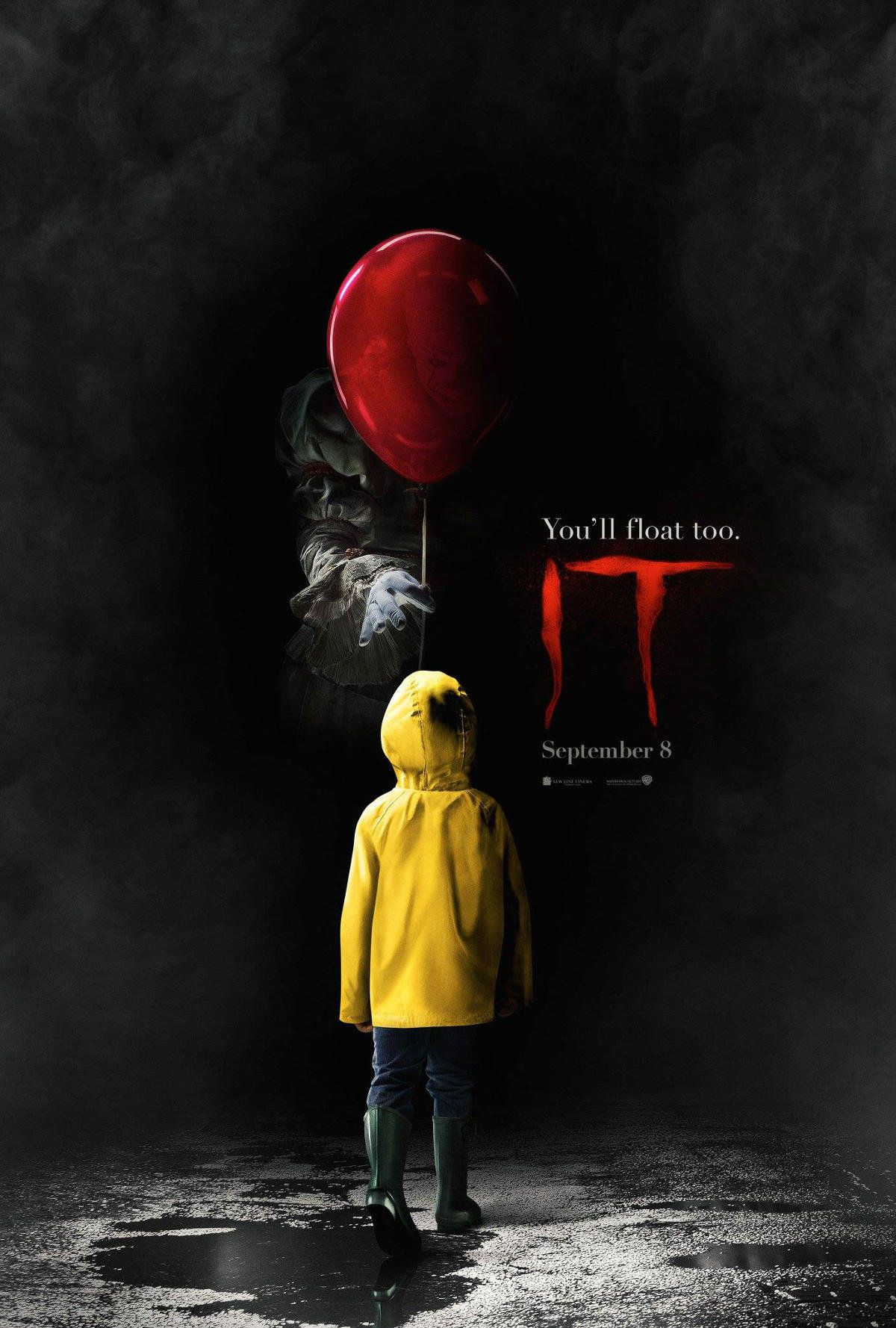Pennywise’s origin story in IT shows the complex mythology behind the terrifying horror movie monster. Pennywise the Clown is a supernatural foe who has all kinds of nightmarish powers at his disposal to terrify his victims. The residents of Derry, Maine are visited by Pennywise every 27 years, exploiting the greatest fears of his victims who tend to be the youngest and most vulnerable citizens of the cursed town. The two-part IT movie further cemented Pennywise as an iconic horror movie villain while exposing more of his dark beginnings.
Pennywise works as a mystery to his victims, making it all the more terrifying when they are confronted with his incredible power and seemingly unrelenting nature. However, the iconic clown persona that appears to George in the sewer in the first movie is just scratching the surface of the truth behind Pennywise. From where this evil being came from to its terrifying true form, there are a lot of details to be explored in Pennywise’s origin story.
Related
IT True Story: Real-Life Crimes That Inspired Pennywise
Stephen King’s 1986 horror novel IT features a nefarious clown that feeds off of children. Here are the real-life crimes that inspired Pennywise.
Where Pennywise Comes From
Pennywise Arrived On Earth Centuries Ago
Despite his iconic and unsettling appearance, Pennywise is not a clown but rather an ancient, evil being that is perhaps as old as the universe itself. In the novel, the entity IT/Pennywise’s real name is Bob Gray. Bob Gray isn’t human and shares the same origin as IT. The human name was a touch of surrealism on King’s part seen in other novels, offering a juxtaposition to the long unpronounceable names of similar cosmic beings from Lovecraft novels, like Nyarlathotep or Yog-Sothoth. The films chose to drop this to an extent, as it doesn’t translate as well to screens.
IT comes from the void that contains the entirety of existence. This space-beyond-space in Pennywise’s origin story is called the Macroverse (also referred to as the Todash Darkness in Stephen King’s Dark Tower novels). IT’s home dimension is a realm that sits alongside ours in the Macroverse, and Pennywise’s specific corner of cosmic real estate is called the Deadlights. At some point, Pennywise left Deadlight and traveled across the Macroverse, entering our universe.
Pennywise arrived on Earth in a cataclysmic event millions of years ago. He landed in the section of what would become North America, specifically where the town of Derry, Maine, eventually comes to be built. Pennywise slumbered beneath the Earth for millions of years, awaiting the arrival of humankind. When the town of Derry was built in 1715, IT awoke and began a cycle of feeding on the fears of the people of Derry and then resuming hibernation for cycles of 27 to 30 years.
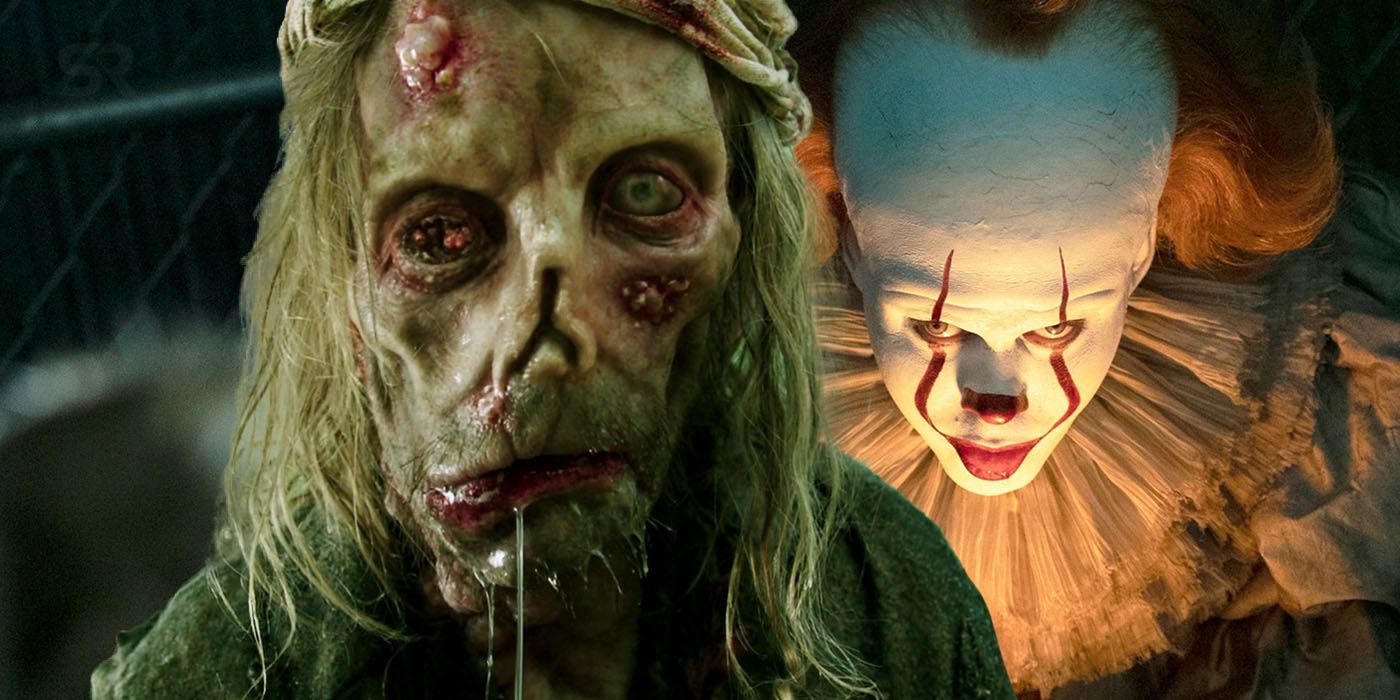
Related
Everything Pennywise Transforms Into In IT Chapter One & Two
Pennywise the clown likes to shapeshift, and took many different forms in IT: Chapter One and Two. Here’s everything IT transformed into.
Why Pennywise Eats Kids
How Has Pennywise Gone Unnoticed?
The clown in IT doesn’t technically eat kids — it consumes their fear, but the process is fatal. Pennywise/IT preys on the children of Derry because their fears are easier to manifest into a physical form and harvest. King decided for IT to predominantly take the shape of Pennywise the Dancing Clown because he believes “clowns scare children more than anything else in the world.”
IT influences the adults of Derry to passively ignore it and not interfere with his attacks on Derry’s children. However, he’s not above consuming adults when the mood strikes. Because IT manipulates the minds of the people of Derry, they don’t dwell on the tragedies that occur. Therefore, despite the number of children who go missing, adults just passively post new missing photos over the old ones and continue on as if nothing is wrong.
Pennywise isn’t just responsible for spates of missing children every 27-30 years though. As Ben (Jeremy Ray Taylor) discovered when he researched Derry’s history in the library, IT has been a part of the terror and death in Derry for centuries. Pennywise was responsible for the explosion at the Kitchener Iron Works that killed 108 people, including 88 children.
IT can also be awakened by an act of violence on top of Pennywise’s 27-30 year cycle. The 1986 Stephen King’s IT novel begins with a boy named Dorcey Corcoran being beaten to death by his stepfather, Richard Macklin, in 1957, which awakens Pennywise. Pennywise primary goal is terrifying and subsequently consuming children, but he also simply relishes and causes violence, mayhem, and general carnage.
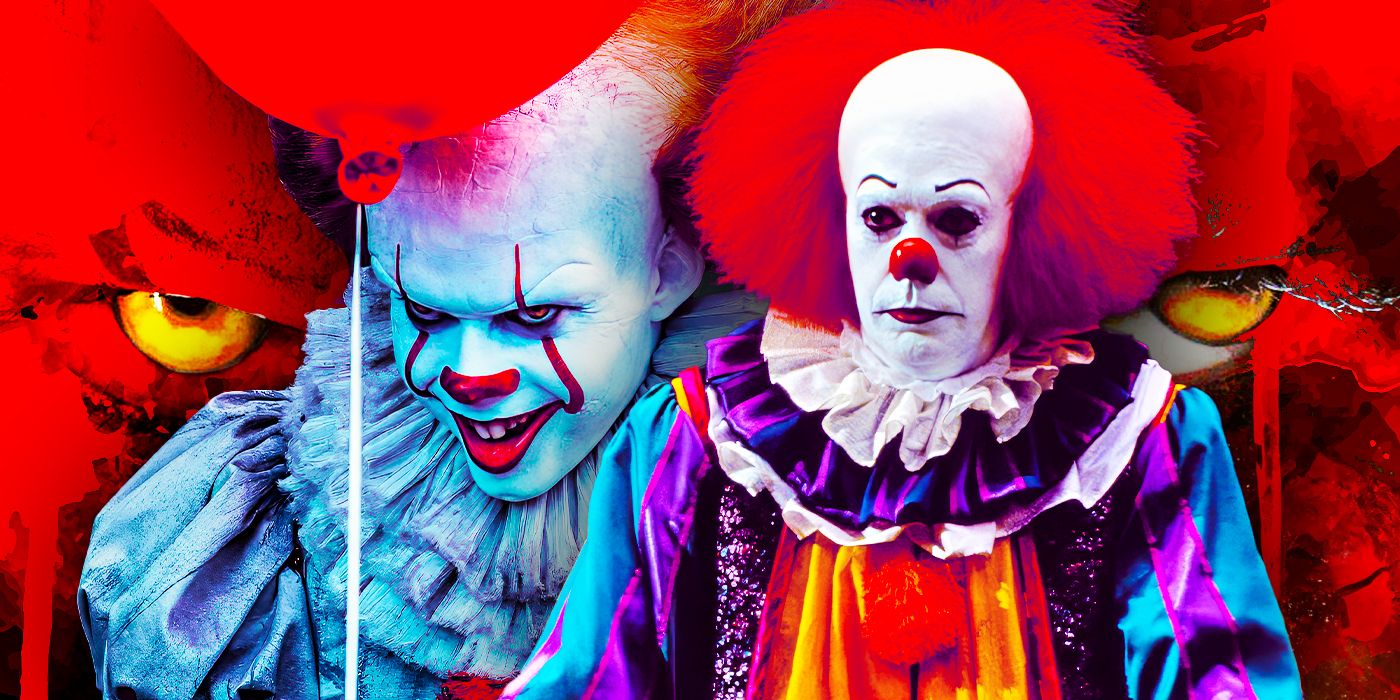
Related
15 Creepiest Pennywise Quotes From The IT Movies & Miniseries, Ranked
While Pennywise says many horrifying things throughout the IT movies and miniseries, some quotes from the clown are creepier than others.
What Is Pennywise’s True Form?
Pennywise Takes Multiple Forms Over The Course Of The Movie
Pennywise is a shapeshifter that takes the form of whatever its victim fears the most. Pennywise the Clown, offering children balloons as it did to little Georgie (Jackson Robert Scott) at the start of the first IT movie, is just the preferred physical form though. IT takes many other shapes, such as a homeless leper chasing Eddie (Jack Dylan Grazer) and the woman in the painting that terrifies Stan (Wyatt Oleff).
In the novel, IT takes on even more shapes, like a giant spider and several famous monsters the producers of IT don’t have the cinematic rights to. These included Dracula, the Wolfman, the Creature from the Black Lagoon, Frankenstein’s Monster, the shark from Jaws, and Rodan.
In the original Stephen King novel IT, Billy (Jaeden Lieberher) glimpsed Pennywises’s true form in the Deadlights for a moment, and he described it as an endless, crawling, hairy creature made of orange light. Though IT likes to manifest itself as a male clown named Pennywise, in the novel, IT also takes the form of an enormous female spider.
In IT: Chapter 2, Richie (played by Bill Hader) also glimpses Pennywise’s true form at the film’s climax. In IT Chapter 2, Pennywise is shown as a trio of glowing lights swimming among infinite walls of what appears to be red-hot flesh. The experience is enough to cause Richie’s eyes to roll back in his skull, and viewing the Deadlights nearly kills him. This was a great direction for the movie adaptation to take since IT/Pennywise is supposed to be a cosmic entity and godlike presence in King’s wider fictional canon.
IT’s natural enemy is another supreme being from the Macroverse called The Turtle. The Turtle also appears in The Dark Tower series as Maturin, one of the Guardians of the Beam, but IT describes himself as “the superior being.” Whether Pennywise is more powerful than The Turtle isn’t known. However, the fact it’s debatable in the context of Maturin being one of the entities holding King’s cross-title fictional reality together is a testament to Pennywise being truly powerful.
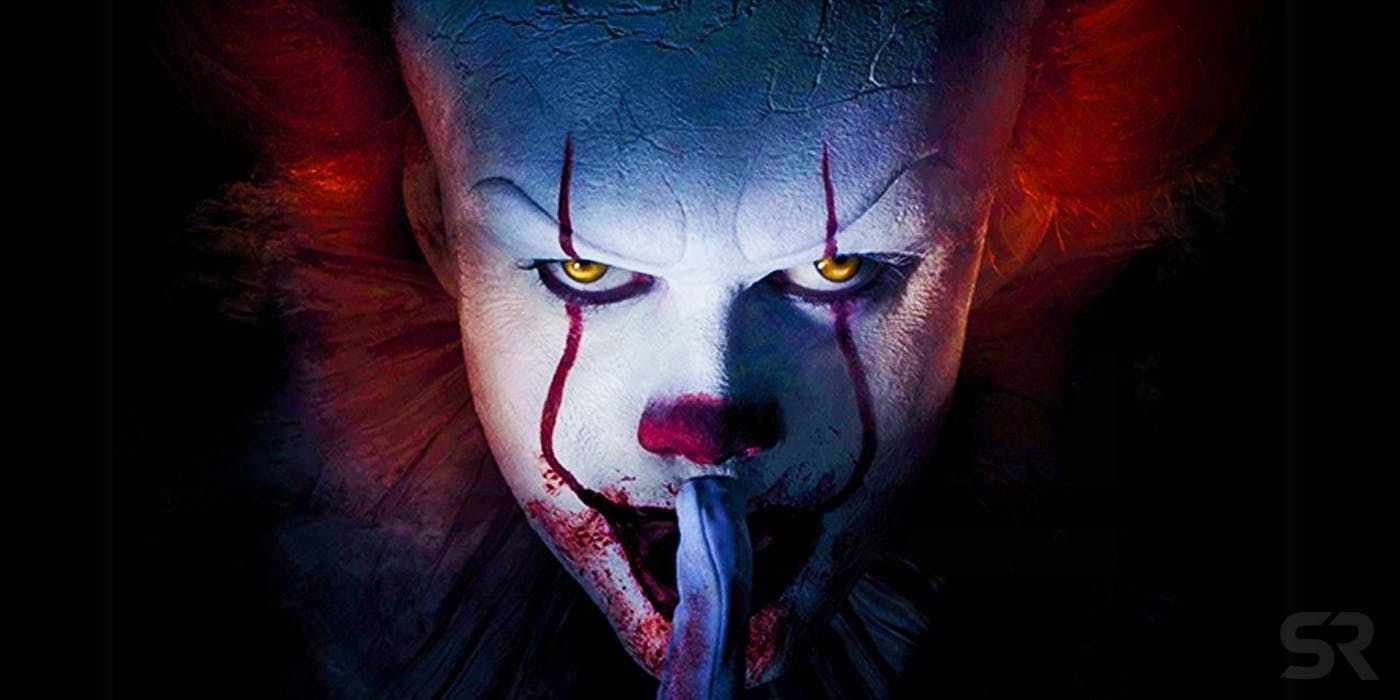
Related
IT: Evolution Of Pennywise The Dancing Clown
Pennywise the Dancing Clown from Stephen King’s IT has underwent significant evolutions for film and TV since its emergence in 1989.
What Powers Pennywise Has
Does Pennywise Have Weaknesses?
As an ancient supernatural evil, IT has a plethora of superpowers. In addition to shapeshifting, Pennywise can also cast illusions. It was IT that manifested the fire responsible for killing Mike’s (Chosen Jacobs) parents. IT can project himself into photographs like the slideshow of Billy’s family the Losers watched in Billy’s garage and can appear and disappear at will. This last power is demonstrated when he shows up in the woods to watch when Mike is being attacked by Henry Bowers (Nicholas Hamilton) and his gang of thugs.
Pennywise’s most lethal power is the ability to manipulate how people perceive reality, which is how IT got away with centuries of violence. This power is why Alvin Marsh (Stephen Bogaert), the abusive father of Beverly (Sophia Lillis), couldn’t see that their entire bathroom was covered in blood after IT attacked Beverly.
When the Losers found Pennywise’s lair in the sewers, they saw the corpses of every IT child victim floating above — one example of the telekinesis he possesses. Despite all of IT’s powers, however, he proved vulnerable to physical attack once the Losers were able to overcome their fear of Pennywise.
IT is able to regenerate himself, as he did when Beverly speared Pennywise through his head, but only up to a point, and this is diminished if his attacker isn’t afraid. After the amount of physical damage he took from the combined and emboldened Losers, Pennywise had to retreat to the bowels beneath Derry to go back to slumber and regenerate for 27 years.
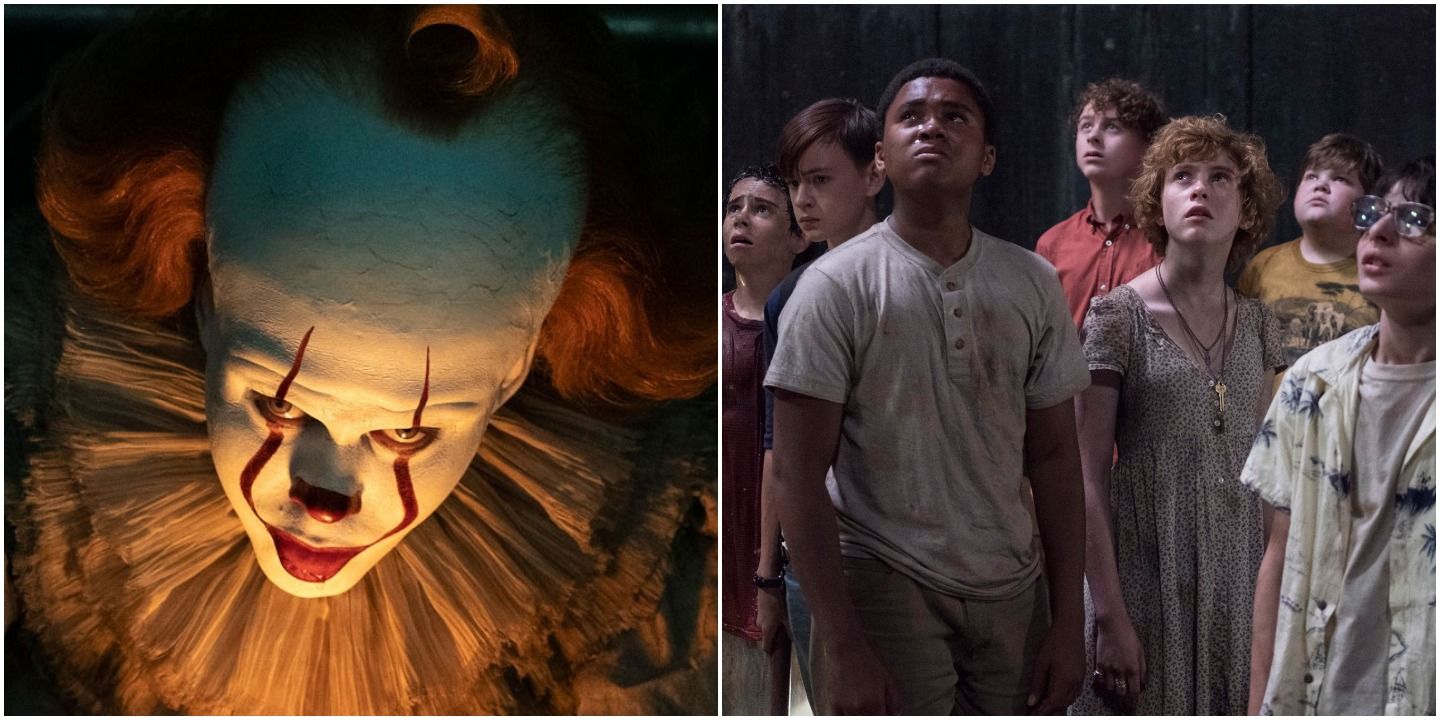
Related
15 Facts About Pennywise That Were Left Out Of IT Chapter One & Two
Both IT and its sequel, Chapter Two, certainly did justice to Pennywise. But fans of the novel will be quick to note that these facts were left out.
Why Pennywise Isn’t Bob Gray In The Movies
Where Did The Clown Image Come From?
The movies have a different approach when it comes to the Pennywise origin story, with IT’s name being Robert “Bob” Gray. In IT: Chapter 2, there is a lengthy exposition section explaining the origins of Pennywise the Dancing Clown. There was a human Pennywise the Dancing Clown, but IT just took his form. In the movie canon, Pennywise the Dancing Clown was a real person whose image IT decided was terrifying enough for its needs.
The scene where Ms. Derch told Pennywise the Dancing Clown’s origin story in IT: Chapter 2 created an apparent plot hole, but this is just because it didn’t explain itself clearly enough. To illustrate, if IT had originally arrived at the bottom of Camp Crystal Lake, he would likely have taken the form of Jason Voorhees, or Leatherface if in Texas. Pennywise the Dancing Clown is never named Bob Gray in the movies, nor is the name said aloud, but many fans mistakenly connect the two and presume Robert Gray is the human in the photograph.
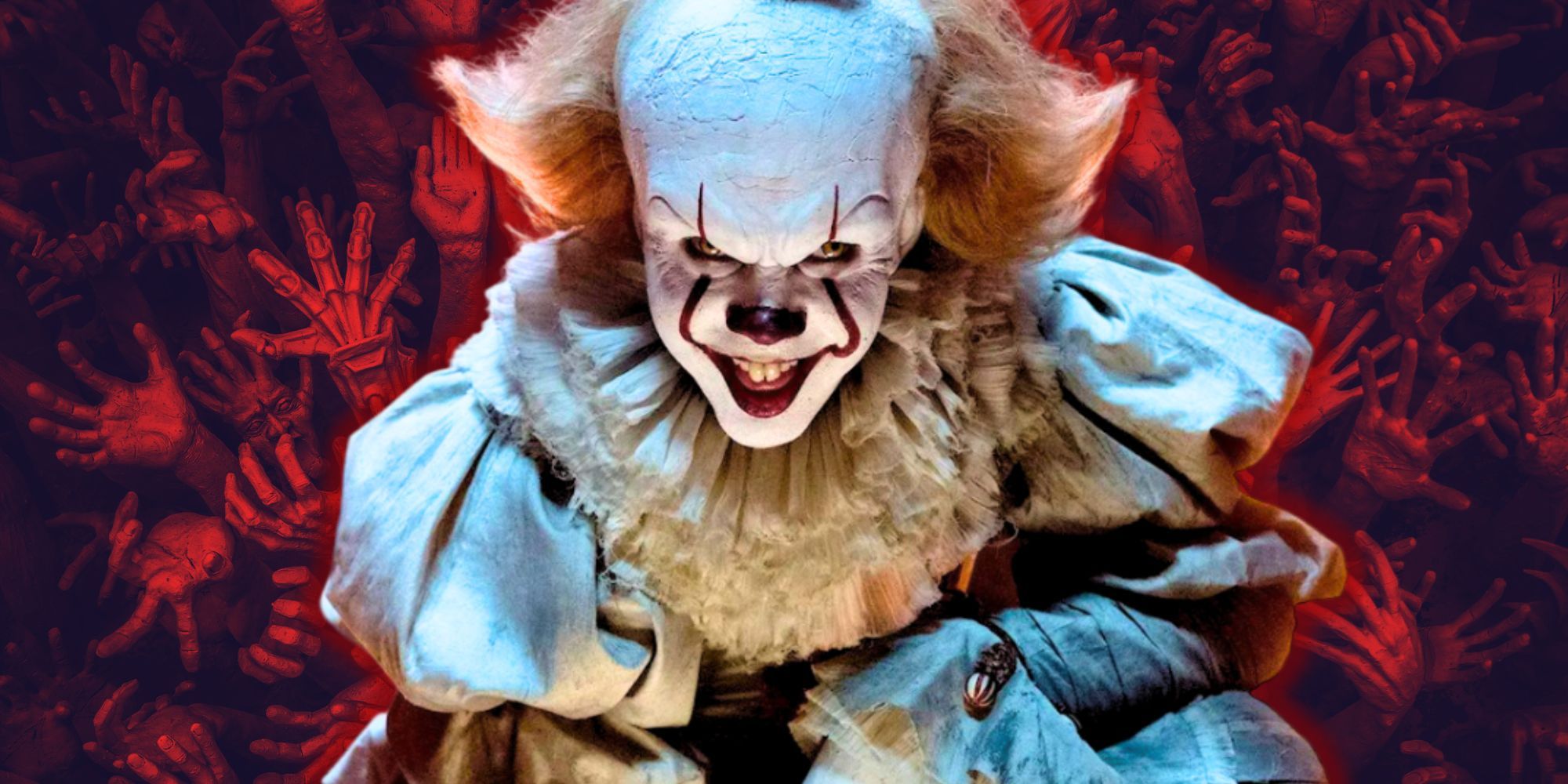
Related
Pennywise’s Kill Count Is SO Much Higher Than The IT Movies Revealed
IT’s main villain, Pennywise, becomes even more terrifying when taking into account their full kill count, and the number is higher than expected.
Were The Changes Made To Pennywise Good?
The Reworked Pennywise Origins Worked For The IT Movies
The origins of Pennywise in IT and IT Chapter Two were changed significantly from Stephen King’s original 1986 novel. While there may be some fans of the book who didn’t like the alterations, it’s difficult to argue that they weren’t positive and more suitable for the on-screen adaptation. The origins of Pennywise in Stephen King’s IT novel were both quite ambiguous and, in many ways, incredibly complex.
Stephen King’s version of Pennywise was a cosmic horror being that required a lot of explanation when it came to its history and backstory. The movies kept some of the core aspects of this, such as Pennywise hailing from the inter-dimensional realm known as the deadlights. However, there were also some convoluted aspects to the on-page version of IT that would simply have felt clunky for an on-screen version of the character.
Aspects of Pennywise like his connection to the Macroverse and Stephen King’s wider shared horror universe simply wouldn’t have worked in the IT movies. Andy Muschietti’s version of the killer clown exists in a standalone story, with no connections to a wider horror cosmology like its on-page counterpart. Streamlining the origins of Pennywise for IT and IT Chapter Two was a good choice when adapting King’s novel. Muschietti managed to ensure the character remained mysterious, but also gave it a more digestible backstory that didn’t risk confusing viewers.
It must also be noted that, despite the changes, the new Pennywise origins in the IT movies didn’t lost the core aspects of the character. Pennywise, in both versions, is an interdimensional being that visits Earth to feed. The changes weren’t dramatically different, and definitely didn’t alter what makes Pennywise such a terrifying presence to the people of Derry. With this in mind, it’s safe to say that the changes to the Pennywise backstory for the IT films were good and justified.
What The Movies Changed About Pennywise From The Book
The More Complex Ideas From King’s Novel Were Simplified
The 2017 IT and 2019 IT: Chapter 2 change a lot of details from the original Stephen King novel, especially when it comes to Pennywise. As mentioned, the uncannily normal name Bob Gray was dropped for the movies. While a Lovecraftian cosmic being with one of the most mundane names ever conceived works in a horror novel, if IT had been named Bob Gray in the movies, it would have left many audience members believing Pennywise used to be a human.
Pennywise also takes many different forms in the novel. These were removed from the movie for licensing reasons, especially since some were characters like the shark from Jaws and Rodan from the Godzilla movies. The methods Pennywise uses in the book vary slightly too, and his list of victims is larger. Books featuring Pennywise also make many allusions to Stephen King’s fictional universe, but understandable references to The Turtle are removed in IT and IT: Chapter 2.
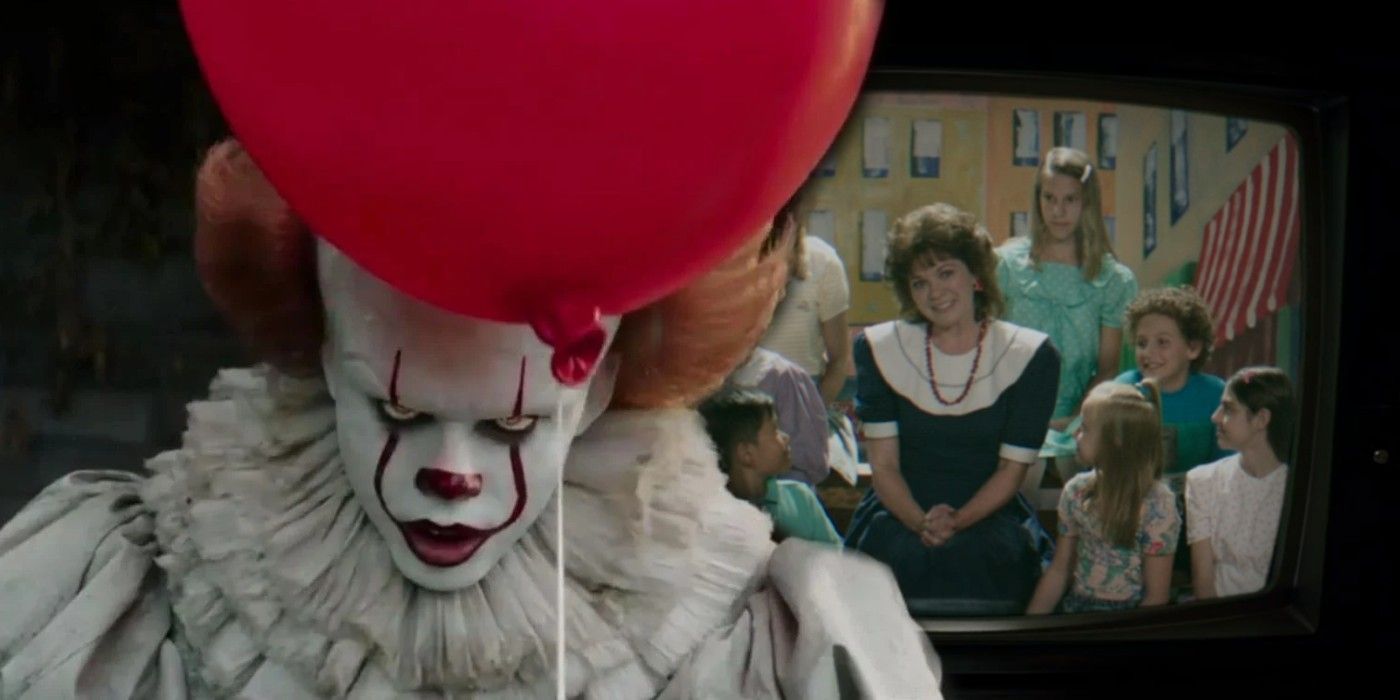
Related
Stephen King’s IT: Why Pennywise’s History Would Be Better As A TV Show
IT has been adapted several times, but each time Pennywise’s history is condensed. Here’s how It’s history could be told better through a TV show.
HBO Are Going To Explore Pennywise Origins In A Prequel Series
The Series Will Focus On The Town At The Center Of Pennywise’s Reign Of Terror
The Pennywise origin story is going to be revealed in full in the upcoming HBO prequel series Welcome to Derry. Plenty of Stephen King stories are set in the fictional town of Derry, Maine, with IT by far being the most memorable. The 2011 movie Bag of Bones is also set in the town. However, it looks as though the IT prequel series will be exclusively focusing on the tales told in IT. Andy Muschietti’s IT brought in fans of the franchise old and new, and it’s become quite popular over the years thanks to his two recent feature films.
Likely, Welcome to Derry will zero in on the other stories in King’s novel about the town. Pennywise’s origin story sees the monstrous beast returning to the town every 27 years to create unspeakable tragedies and chaos, with the first recorded instance seeing 340 unnamed settlers perish. While all of Pennywise’s exploits are told in broad strokes during IT: Chapter 1 and Chapter 2, he’s mainly responsible for every horrible event that happened in the town’s history. The prequel series will probably explore these horrific instances, further adding color to the origin story.
Going with a prequel series, rather than something like IT: Chapter 3, is a smart move on the studios’ part. A television show format allows for greater exploration of a character that has become such a pop culture fascination over the years. In addition, prequel series are incredibly popular right now, with the Star Wars franchise leading the pack with properties like Andor and Obi-Wan Kenobi.
Bigger questions can be answered about the mysterious celestial beast, like why he returns every 27 years or how he came down on an asteroid. Surely others besides the Losers Club have encountered Pennywise before, and now, the Pennywise origin story can be fully fleshed out with the IT prequel series Welcome to Derry.

